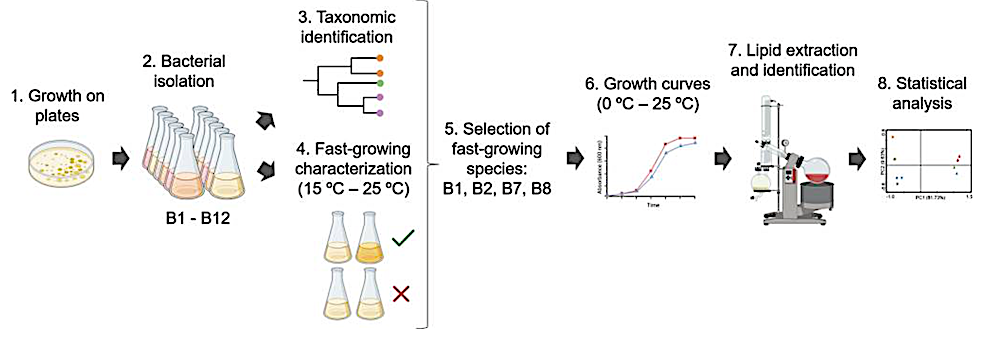Ancient Antarctic microbial mats harbour viable bacteria that have been exposed to extreme cold and arid conditions for hundreds of years.
To delve into the molecular mechanisms underlaying their survival, we isolated 12 bacterial strains from a 1,000-year-old desiccated microbial mat from the McMurdo Ice Shelf and studied their lipid composition as a function of temperature.
Six of the bacterial strains were classified as Paenisporosarcina macmurdoensis, and the other six as Arthrobacter sp., according to 16S rRNA gene analyses.

Methodological scheme to assess the influence of temperature on the lipid composition of extremophilic bacteria isolated from a 1,000-year-old microbial mat from Antarctica. 1. Bacterial growth on plates and colony selection; 2. Bacterial isolation of 12 strains (B1-B12, based on distinct colour and morphology) on liquid and solid R2A or LB media; 3. Taxonomic identification of the 12 bacterial strains by 16S rRNA gene analysis; 4. Identification of fast-growing bacteria by incubating the 12 isolates at 15 ºC, 20 ºC and 25 ºC for two months on liquid R2A or LB media; 5. Selection of fast-growing bacterial strains of different species (i.e., Paenisporosarcina macmurdoensis B1 and B2, and Arthrobacter sp. B7 and B8); 6. Growth curves of the selected strains at distinct incubation temperatures (from 0 ºC to 25 ºC); 7. Lipid extraction of the selected strains incubated at their maximum and minimum growth temperatures, and 8. Multivariate statistical analysis. Figure made using BioRender software — Microbial Ecology via PubMed
Two strains of each taxon were incubated at their minimum and maximum growth temperatures, and the changes in their lipid profiles were analyzed. The proportion of major fatty acids (saturated, unsaturated, and iso- and anteiso-) remained relatively constant across temperature in the four strains, but the composition of hydrocarbons and alcohols differed between taxa (e.g., presence of unsaturated alkenes in Arthrobacter sp., or unidentified isoprenoid alcohols in P. macmurdoensis).
This highlights the diagnostic value of non-fatty acid lipids and revealed a taxon-dependent lipid composition. Despite the taxon-associated lipid profile, incubation temperature also influenced lipid composition in both taxa, with higher temperature correlating with greater lipid richness.
Interestingly, the two P. macmurdoensis strains showed distinct lipid profiles at 20°C, suggesting that intraspecific lipid diversity reflects within-species physiological variability with potential relevance for adaptation to temperature fluctuations in the mat.
Therefore, assessing the influence of temperature on bacterial lipids is crucial for understanding their adaptation and survival in extreme environments, as well as for expanding species lipid inventories for biological interpretations of ancient samples.
Temperature-Sensitive Lipids Reveal Intraspecific Diversity in Bacteria Isolated from an Ancient Antarctic Microbial Mat, Microbial Ecology via PubMed
Astrobiology,
